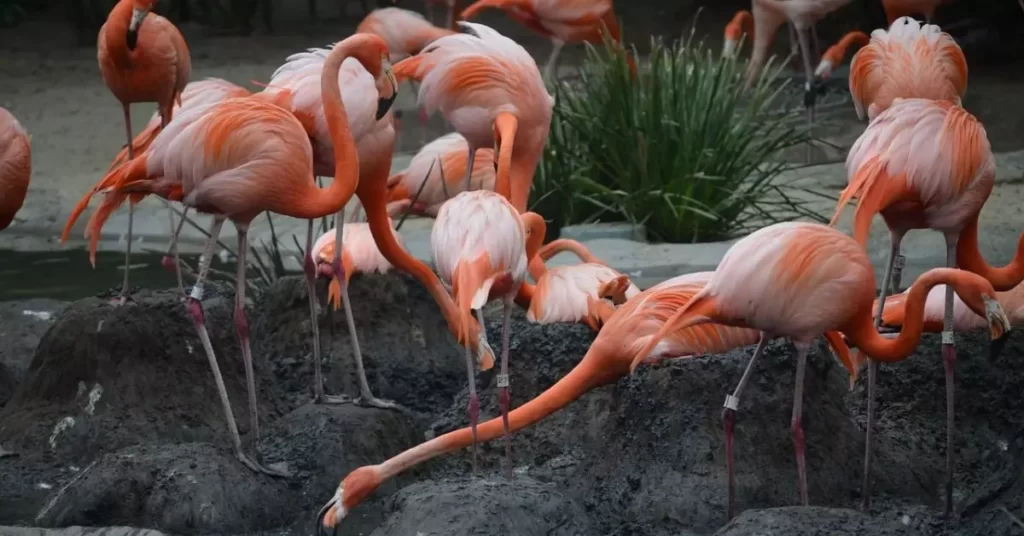The American flamingo is a large species of flamingo closely related to the greater flamingo and the Chilean flamingo.
Greater flamingo has the longest legs and body size.
The bill is characteristically curved downward, and is pale yellow at the base, pink to orange in the middle, and black at the tip.
Fun Facts About American Flamingos:
The American flamingo is a very noisy bird. Its voice plays an important role in keeping the herd together.
Sounds vary according to the type of activity, usually low gobbling during feeding and snoring during flight. Courtship displays may be accompanied by growls and roars.
American flamingos occasionally swim, rising like ducks, paddling their feet to maintain their position. These large flamingos can reach down to 120-130 cm, which enables them to access more food.
Every day flamingos spend 15-30% of their time cleaning their feathers, using their beaks to spread oil produced from a special gland on the feathers.
The flamingo’s visible “knee” is actually an ankle joint. The actual knees are close to the body and hidden by feathers.
A flamingo has 19 bones in its neck, and its feathers and beak are made of a strong substance called keratin.
Population size: 260-330 thousand
Lifespan: 40-50 YRS
Top speed: 60 km/h
Weight: 2.2 – 2.8 kg
Height: 1.2 – 1.4 m
Wingspan: 1.5 m
Their plumage is deep pink/red/orange and they are the brightest in plumage of all flamingo species.
Young birds are gray in color, their feathers gradually becoming pink as they mature.
Where American Flamingo Lives:
The American flamingo lives on the northern coast of South America, the Yucatan Peninsula of Mexico, and some Caribbean islands.
There is also a small isolated population that lives in the Galapagos Islands. It inhabits a variety of freshwater and saltwater habitats such as lagoons, estuaries, coastal and inland lakes, and mudflats.
Habits and Lifestyle:
Flamingos live, feed and breed in large flocks, which can number in the thousands. When mating and interacting with others in the colony, they use highly ritualistic displays.
American flamingos spend most of the day feeding. They are shy and fly away when disturbed.
A bird claims a “territory” and does not allow others to come near. If someone gets too close, the bird that is offended will display a warning threat, causing the intruder to leave.
A colony establishes distinct areas where birds can freely interact, the drinking area being one such place.
Like other flamingo species, American flamingos will migrate short distances until they find enough food or their current habitat is disturbed in some way.
Although their flight is not as long as other migratory birds, flamingos still fly without eating.
Team Name: Colony, Flamboyance, Stand, Regiment
Lifestyle: Semiaquatic, Wedding Birds, Precocial, Soaring Birds, Shorebirds
Seasonal Behavior: Migration
Diet and Nutrition:
American flamingos eat mainly brine shrimp, molluscs, but also marine worms, insects and algae.
Flamingos eat deliciously. They stick their beaks upside down in the water and suck the water. They then pump water from the sides of their beaks.
Small animals and plants continue to provide a tasty meal.
Diet: Carnivorous
Duration of Incubation: 27-31 days
Independent age: 70-75 days
American flamingos are monogamous, with strong, long-term pair bonds.
They engage in group displays, with thousands of birds turning their heads, lowering their necks, or raising their wings in spectacular coordination.
These displays ensure that members of the colony are ready to mate at the same time.
These birds mate after the rainy season, usually in spring or summer.Both parents nest.
Usually, only one egg is laid and incubated by the male and female for 27 to 31 days.
Both parents feed the young, with the common “crop milk” that is secreted in the adult’s upper digestive tract.
The chick is brooded for about 5-15 days and then it gathers with other chicks in a large crèche which is looked after by several adults.
It fledges at about 70-75 days of age and is reproductively mature at 3-5 years of age.
American flamingos are threatened by human disturbance and habitat loss along Caribbean coastal wetlands.
Population numbers:
The IUCN Red List estimates that mature individuals number around 260,000–330,000 birds.
Overall, the number of this species is increasing today, and it is classified as Least Concern (LC).Ecological niche American flamingos eat large amounts of crustaceans, aquatic invertebrates and algae and therefore have a large impact on these populations.

